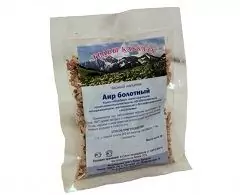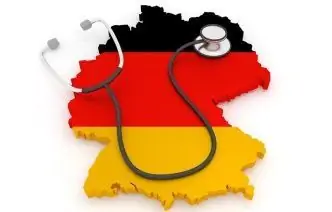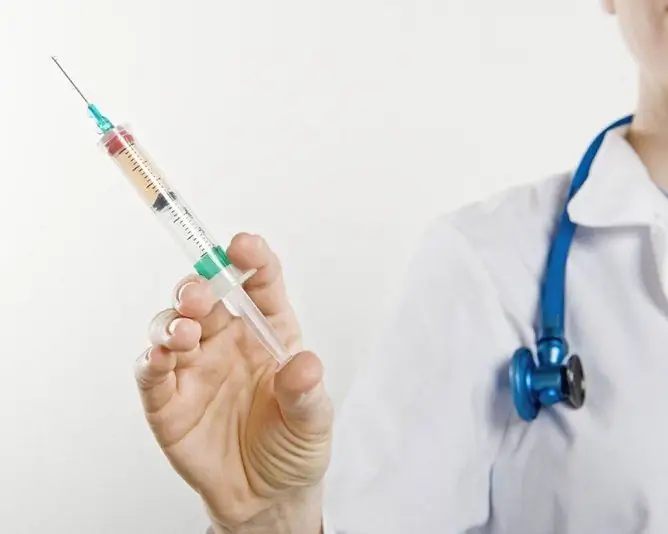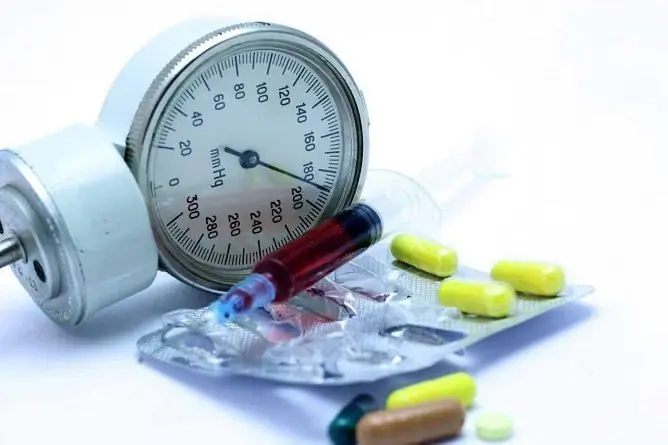Table of contents:
- Tramal
- Release form and composition
- Indications for use
- Contraindications
- Method of administration and dosage
- Side effects
- special instructions
- Drug interactions
- Analogs
- Terms and conditions of storage
- Terms of dispensing from pharmacies

Video: Tramal - Instructions For Use, Indications, Doses, Analogues

2024 Author: Rachel Wainwright | [email protected]. Last modified: 2023-12-15 07:39
Tramal
Instructions for use:
- 1. Release form and composition
- 2. Indications for use
- 3. Contraindications
- 4. Method of application and dosage
- 5. Side effects
- 6. Special instructions
- 7. Drug interactions
- 8. Analogs
- 9. Terms and conditions of storage
- 10. Terms of dispensing from pharmacies

Tramal is an opioid synthetic analgesic with a mixed mechanism of action.
Release form and composition
- capsules: size No. 4, gelatinous hard, glossy, elongated, with Snap fit system of fastening closure; the capsule cap is green, the body is light yellow, the GRUNENTHAL logo is applied in black on both parts; contents of capsules - fine powder, odorless, color from white to pale yellow (10 pcs. in blisters, in a cardboard box, 2 packages);
- rectal suppositories: homogeneous wax-like structure, from white to pale yellow, odorless (5 pcs. in contoured cell-free packs, in a cardboard box, 1 pack);
- solution for injection: clear, colorless liquid, free from mechanical impurities, odorless (2 ml in ampoules, 5 ampoules in contour plastic packaging, in a cardboard box, 1 package);
- drops for oral administration: a transparent, slightly viscous liquid from colorless to slightly yellow, with a specific smell of peppermint and a weak aroma of anise (10 ml in vials).
Composition of 1 capsule:
- active substance: tramadol hydrochloride - 50 mg;
- auxiliary ingredients: anhydrous colloidal silicon dioxide, sodium starch glycolate (type A), microcrystalline cellulose, magnesium stearate;
- capsule cap: titanium dioxide, iron oxide yellow, indigo carmine - FD&C Blue 2, gelatin;
- capsule body: titanium dioxide, iron oxide yellow, sodium lauryl sulfate, gelatin;
- black ink: capsugel ink 1028 black.
Composition of 1 rectal suppository:
- active substance: tramadol hydrochloride - 100 mg;
- auxiliary ingredient: solid fat.
Composition of 1 ml solution for injection:
- active substance: tramadol hydrochloride - 50 mg (in 1 ampoule - 100 mg);
- auxiliary ingredients: water for injection, sodium acetate.
Composition of 1 ml drops for oral administration:
- active substance: tramadol hydrochloride - 100 mg (in 1 drop - 2.5 mg);
- auxiliary ingredients: potassium sorbate, sucrose, flavorings, sodium saccharin, sodium cyclamate, glycerol, polyoxyethylene- (54) -hydrogenated castor oil, propylene glycol, purified water.
Indications for use
Tramal is used to relieve pain syndrome of various etiologies of moderate and severe intensity in the following cases:
- postoperative period;
- injury;
- pain caused by myocardial infarction (solution for injection);
- oncological diseases;
- painful medical or diagnostic manipulations.
Contraindications
- acute alcohol or drug intoxication (opioid analgesics, hypnotics, psychotropic drugs), aggravated by respiratory depression or severe depression of the central nervous system (CNS);
- drug withdrawal (withdrawal syndrome);
- severe renal impairment with creatinine clearance (CC) <10 ml / min;
- severe liver dysfunction;
- use simultaneously with monoamine oxidase inhibitors (MAO) and within two weeks after their cancellation;
- individual hypersensitivity to opioid analgesics, tramadol and other ingredients of Tramal.
During pregnancy and during breastfeeding, Tramal is recommended to be used exclusively for health reasons, while therapy should be limited to a single dose of the drug.
In renal / hepatic insufficiency, a prolongation of the effect of tramadol is likely, which may require an increase in the interval between single doses for this category of patients.
Method of administration and dosage
The solution for injection is administered intravenously, intramuscularly or subcutaneously.
Oral forms of Tramal are taken before, during or after meals; the capsules are washed down, and the drops are dissolved in a small amount of liquid or dripped onto a piece of sugar, and then taken.
Rectal suppositories are intended to be inserted into the rectum.
Doses of the drug are set by the attending physician, depending on the intensity and localization of the pain syndrome.
The duration of therapy should not exceed the time required to relieve the pain symptom.
Recommended dosage:
- children over the age of 1 year: Tramal is used in the form of oral drops and solution for injection; a single dose is determined at the rate of 1–2 mg per kg of body weight, the daily dose is 4–8 mg / kg;
- adults and adolescents over 14 years of age: use all forms of drug release; single dose - 50-100 mg (20-40 drops, 1-2 capsules, 1-2 ml solution for injection, 1 suppository); in the absence of satisfactory analgesia after a single use of tramadol, a single dose of 50 mg can be reapplied after 30-60 minutes;
- elderly patients (≥ 75 years): due to the possible delayed elimination of the drug from the body, it may be necessary to increase the interval between doses, taking into account the individual characteristics of the patient.
Usually, 400 mg / day of tramadol hydrochloride is sufficient to relieve pain; relief of severe pain can be started with a single dose of 100 mg. Higher doses can be used in the postoperative period and for the treatment of pain symptoms in cancer.
Side effects
- digestive system: often - dry mouth, nausea; rarely - abdominal pain, vomiting, constipation, bloating; isolated cases - a change in appetite;
- nervous system: often - feeling tired, dizziness, confusion, drowsiness; rarely - headache, mood swings (in most cases - improvement, rarely - depression), changes in activity (in most cases - decrease, less often - growth), impaired sensations and behavioral reactions; isolated cases - cerebral convulsions (mainly with the introduction of intravenous tramadol in high doses, or simultaneously with the use of antipsychotics);
- cardiovascular system: isolated cases - tachycardia, heart rhythm disturbances, fainting, collapse (especially when the patient is in an upright position or during physical exertion);
- skin reactions: rarely - rash, redness;
- musculoskeletal system: isolated cases - muscle (motor) weakness;
- respiratory system: data on the inhibition of respiratory function when using Tramal in the form of rectal suppositories and capsules has not yet been reported, but such an effect cannot be completely excluded, especially if the recommended doses are significantly exceeded, or with the simultaneous use of other medicinal substances that have a depressing effect on the central nervous system;
- other reactions: often - increased sweating, especially with rapid intravenous administration; isolated cases - difficulty in swallowing water.
Symptoms of an overdose of tramadol are: epileptic seizures, states from fainting to unconsciousness (coma), drop in blood pressure, constriction / dilation of the pupils, palpitations (tachycardia), difficulty in breathing up to apnea.
Since Tramal is an opiate agonist, it is recommended to stop its effects in case of an overdose with morphine antagonists (for example, naloxone). The convulsions that appear as a result of taking toxic doses of tramadol should be eliminated with drugs from the benzodiazepine group.
special instructions
Under the supervision of a doctor, due to the increased likelihood of complications, the drug is prescribed to patients with impaired renal / liver function, traumatic brain injury, increased intracranial pressure, epilepsy, drug dependence on opioids, unexplained genesis of pain in the abdominal cavity (symptom complex "acute abdomen"), dysfunctions of the respiratory center or respiratory depression, confusion of consciousness of unknown origin.
During tramadol therapy, the condition of patients with generalized seizures requires careful monitoring.
After prolonged use of Tramal, the possibility of developing drug dependence cannot be completely ruled out. Therefore, only the attending physician has the right to decide on the duration of the course of drug therapy and the need to interrupt it. The patient is required to be warned about the need to carefully follow the dosage regimen prescribed by the doctor and the inadmissibility of transferring the drug to others. In the case of chronic pain syndrome, long-term treatment is carried out only according to strict indications.
During the use of Tramal in any dosage form, the use of alcohol must be excluded.
When using tramadol, the patient should refuse to perform work that requires an increased concentration of attention and speed of psychomotor reactions, since it may have a rather strong effect on psychophysical abilities, including a slowdown in reaction, a decrease in attention.
Drug interactions
- ethanol and drugs that have a depressing effect on the central nervous system: tramadol enhances their effectiveness;
- inducers of microsomal oxidation (barbiturates, carbamazepine): inhibit the analgesic effect and reduce the duration of the Tramal effect;
- opioid analgesics / barbiturates with long-term use: stimulate the development of cross-tolerance (anxiolytics increase the severity of the analgesic effect of tramadol, and barbiturates increase the duration of anesthesia);
- naloxone: activates respiration, eliminates analgesia from the use of opioid analgesics;
- MAO inhibitors, furazolidone, procarbazine, antipsychotics: the seizure threshold decreases, the risk of seizures increases;
- quinidine: increases the plasma concentration of tramadol, reducing the content of the mono-O-desmethyltramadol metabolite by competitive inhibition of the CYP2D6 isoenzyme.
Analogs
Tramal's analogues are: Tramadol, Plazadol, Tramadol Stada, Tramadol-Acri, Tramadol-GR, Tramadol-Pletchiko, Tramaclosidol, Tramal Retard, Tramolin, etc.
Terms and conditions of storage
Store at temperatures up to 25 ° C. Keep out of the reach of children.
Shelf life: injection solution, capsules, suppositories - 5 years; drops for oral administration - 4 years.
Terms of dispensing from pharmacies
Dispensed by prescription.
Tramal is included in the list of potent substances of the Standing Committee on Drug Control of the Ministry of Health of the Russian Federation.
Information about the drug is generalized, provided for informational purposes only and does not replace the official instructions. Self-medication is hazardous to health!
Recommended:
Spring Adonis - Properties, Indications For Use, Reviews

Adonis is a herbaceous plant from the genus of buttercups. The pharmaceutical industry produces on the basis of adonis tincture and tablets of Adonizid, which are prescribed for cardiac neurosis, vegetative vascular dystonia, etc
Marsh Calamus - Indications For Use, Properties

Calamus marsh has a beneficial effect on digestion and reduces gas formation in the intestines
Althea Officinalis - Properties, Indications For Use

Marshmallow is a medicinal plant with expectorant and anti-inflammatory properties
Vitamin B5 - Biological Value, Indications For Use

Vitamin B5 is a water-soluble vitamin (aka calcium pantothenate or pantothenic acid). Takes part in the metabolism of amino acids, fats and carbohydrates
Ergot - Useful Properties, Application, Indications, Doses

Ergot is a parasitic fungus of the ergot family found on some cereals, most often on ears of wheat and rye. In official medicine, drugs made from ergot alkaloids are used to treat nervous disorders, migraines, and uterine bleeding. In folk medicine, ergot is used for headaches, migraines, mental disorders, and also as a vasodilator in the treatment of hypertension






